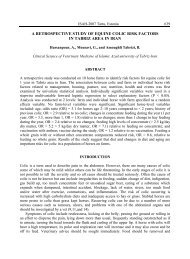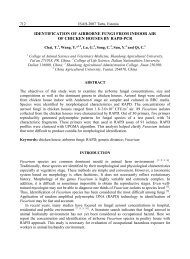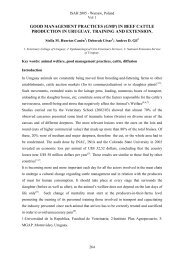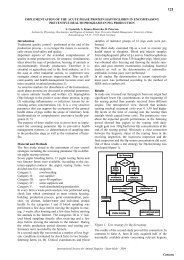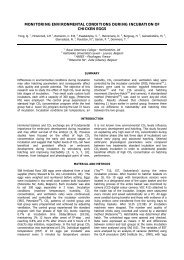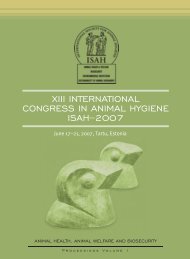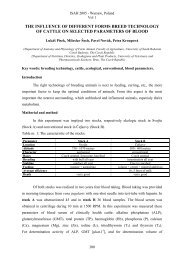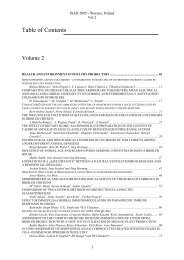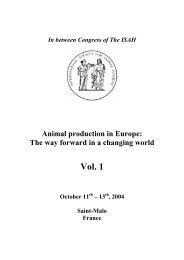EFFECTS OF THE INTRODUCTION OF LACTIC ACID ... - ISAH-SOC
EFFECTS OF THE INTRODUCTION OF LACTIC ACID ... - ISAH-SOC
EFFECTS OF THE INTRODUCTION OF LACTIC ACID ... - ISAH-SOC
You also want an ePaper? Increase the reach of your titles
YUMPU automatically turns print PDFs into web optimized ePapers that Google loves.
<strong>ISAH</strong>-2007 Tartu, Estonia 311<br />
MICROBIOLOGICAL ANALYSIS<br />
At the rearing level<br />
The treatment by the lactic product did not affect the bacterial count of lactic acid bacteria, total<br />
coliforms, Enterococcus and C. perfringens as no significant differences have been observed<br />
between control and treated animals at any sampling period (table 4). However, there is a<br />
significant effect of the rearing period on the means of bacterial count. In general, for all the<br />
microorganisms studied, the lowest count was noted between 7 and 21 days of rearing (table 4).<br />
Table 4. The means of bacterial count in animal faeces (log (10) cfu/g).<br />
Microorganisms Treatments 0–7 days 7–21 days 21–36 days<br />
T0 (control) 9.2 ± 0.6 7.7 ± 0.5 9.3 ± 0.3<br />
Lactic acid<br />
T1 (10 5 cfu/ml) 9.2 ± 0.6 7.7 ± 0.6 9.2 ± 0.4<br />
bacteria<br />
T2 (10 6 cfu/ml) 9.1 ± 0.4 7.9 ± 0.4 9.3 ± 0.6<br />
P=0.739<br />
T0 (control) 8.4 ± 0.4 7.5 ± 0.6 7.9 ± 0.6<br />
Total coliforms*<br />
T1 (10 5 cfu/ml) 8.0 ± 0.4 7.6 ± 0.6 7.8 ± 0.7<br />
T2 (10 6 cfu/ml) 8.0 ± 0.5 7.6 ± 0.6 7.8 ± 0.6<br />
P=0.501<br />
T0 (control) 8.4 ± 0.4 7.5 ± 0.6 7.9 ± 0.6<br />
Enterococcus spp.<br />
T1 (10 5 cfu/ml) 8.0 ± 0.4 7.6 ± 0.6 7.8 ± 0.7<br />
T2 (10 6 cfu/ml) 8.0 ± 0.5 7.6 ± 0.6 7.8 ± 0.6<br />
P=0.746<br />
T0 (control) 4.2 ± 1.9 3.2 ± 1.2 5.0 ± 1.5<br />
C. perfringens<br />
T1 (10 5 cfu/ml) 4.2 ± 0.5 2.5 ± 1.7 2.9 ± 2.1<br />
T2 (10 6 cfu/ml) 4.0 ± 1.2 2.2 ± 1.0 4.1 ± 1.9<br />
P=0.057<br />
Reported values (mean ± standard deviation; n=15) have been statistically analysed using the test of<br />
Kruskall-Wallis or the *Anova where the conditions of normality and homogeneity of variances were<br />
achieved. S: significant (p0.05)<br />
At the processing level<br />
The animals from our experimental rearing have been slaughtered at the beginning of the process<br />
in order to avoid cross contamination with animals coming from other farms. The day of<br />
slaughtering (d36), the lactic product, had no effect on the counts of the microorganisms studied<br />
on neck skins taken from control and treated animals (table 5). The mean counts of lactic acid<br />
bacteria, Pseudomonas and thermophilic coliforms were 5, 3.7 and 4 log(10) respectively.<br />
Table 5. The means of bacterial count on neck skins (log(10) cfu/g) the day of the slaughtering<br />
(d36).<br />
Treatments Lactic acid bacteria Pseudomonas spp. Thermophilic coliforms<br />
T0 (control) 5,1 ± 0,4 3,8 ± 0,4 4,4 ± 0,8<br />
T1 (10 5 cfu/ml) 5,1 ± 0,3 3,8 ± 0,3 4,3 ± 0,6<br />
T2 (10 6 cfu/ml) 5,1 ± 0,3 3,7 ± 0,5 4,2 ± 0,5<br />
p=0.997 p=0.947 p=0.755<br />
Reported values (mean ± standard deviation; n=15) have been statistically analysed using the test of Anova



